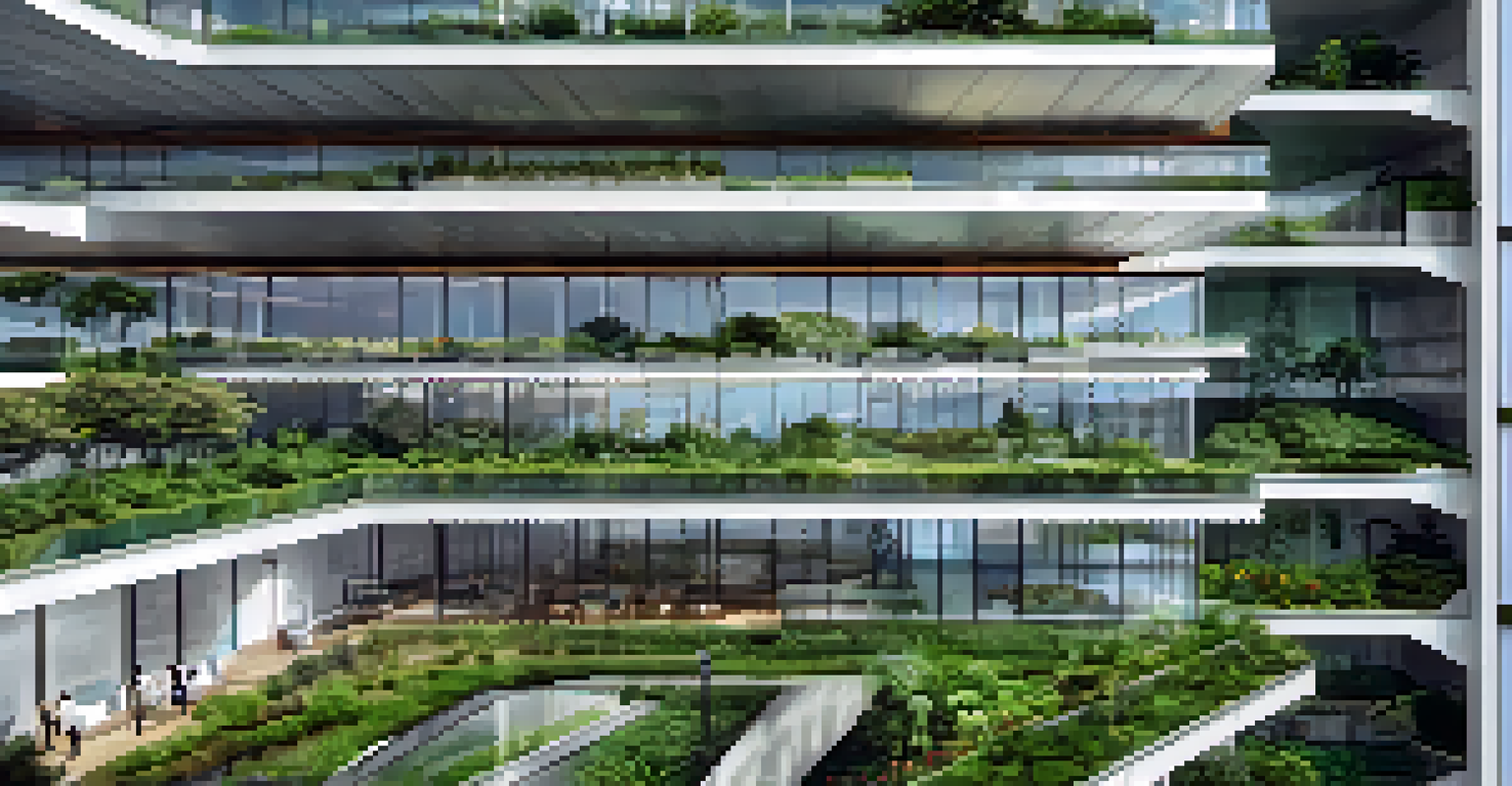The Evolution of Brazilian Architecture: From Past to Present

The Roots of Brazilian Architecture: Colonial Influences
Brazilian architecture has its origins in the colonial period when the Portuguese arrived in the 16th century. They brought with them the Manueline style, characterized by intricate details and maritime motifs. This initial influence laid the groundwork for a unique architectural identity that would evolve over the centuries.
Architecture should speak of its time and place, but yearn for timelessness.
During this period, churches and government buildings were constructed with a blend of European styles and local materials, creating a distinctive aesthetic. One notable example is the São Francisco Church in Salvador, showcasing Baroque elements intertwined with Brazilian artistry. These structures not only served religious purposes but also represented the power dynamics of colonial rule.
As the country evolved, so did the architectural styles, leading to a more eclectic mix of influences. The fusion of indigenous techniques and European designs set the stage for the rich tapestry of Brazilian architecture that we see today.
Neoclassicism and the Rise of Urban Centers
The late 18th and early 19th centuries marked the arrival of Neoclassicism in Brazil, coinciding with the country's growing urbanization. This style, inspired by ancient Greece and Rome, emphasized symmetry and grandeur, reflecting the ideals of the Enlightenment. Cities like Rio de Janeiro began to showcase these architectural advancements as they expanded.

Prominent structures from this era, such as the Municipal Theatre of Rio de Janeiro, display the opulence and refined sensibilities of Neoclassical design. These buildings served as cultural hubs, hosting performances and gatherings that helped shape the national identity. They also symbolized Brazil's aspirations to establish itself as a modern nation.
Colonial Roots Shape Architecture
Brazilian architecture evolved from colonial influences, blending European styles and local materials to create a unique identity.
The influence of Neoclassicism set a precedent for future architectural movements, as urban centers continued to grow and evolve. This period laid the foundation for a more diverse architectural landscape that would soon embrace innovation and experimentation.
Modernism Takes Center Stage in the 20th Century
The 20th century heralded the arrival of Modernism in Brazilian architecture, a movement that broke away from traditional styles and embraced new materials and technologies. Influenced by global trends, Brazilian architects sought to create functional spaces that reflected the spirit of the times. This shift is evident in the works of influential figures like Oscar Niemeyer and Lúcio Costa.
The best buildings are those that are not only functional but also reflect the culture and identity of the people who inhabit them.
Niemeyer's designs, such as the National Congress of Brazil, exemplify the fluid lines and bold forms that characterize Modernist architecture. His innovative use of concrete allowed for dramatic shapes that seemed to challenge gravity, creating landmarks that redefined Brazil's architectural landscape. These structures conveyed a sense of optimism and progress, resonating with the country's aspirations during a time of rapid change.
Modernism also fostered a greater emphasis on social responsibility in architecture, as designers began to address the needs of the communities they served. This focus on inclusivity and functionality continues to influence contemporary Brazilian architecture.
The Role of Brazilian Architecture in National Identity
As Brazil navigated the complexities of its national identity, architecture played a pivotal role in reflecting and shaping cultural narratives. Post-independence, architects sought to create structures that showcased Brazil's uniqueness, often drawing on local traditions and materials. This desire for authenticity led to a rich fusion of styles that represented the diverse cultural heritage of the nation.
Buildings like the Cathedral of Brasília not only served religious purposes but also became symbols of national pride. Designed by Niemeyer, this iconic structure embodies the aspirations of a modern Brazil while paying homage to its roots. Such landmarks have become integral to the collective memory of the nation, representing both historical significance and contemporary relevance.
Modernism Redefines Urban Design
The 20th century saw Modernism emerge in Brazil, focusing on innovative designs and social responsibility, as exemplified by iconic architects like Oscar Niemeyer.
Through architecture, Brazil has been able to express its evolving identity, celebrating both the past and the future. This ongoing dialogue between tradition and innovation continues to shape how Brazilians view themselves and their place in the world.
Sustainability in Contemporary Brazilian Architecture
In recent years, there has been a growing emphasis on sustainability within Brazilian architecture, reflecting global trends towards environmental consciousness. Architects are increasingly incorporating eco-friendly practices and materials into their designs, recognizing the importance of minimizing their ecological footprint. This shift is not just a trend; it's a necessity in addressing climate change and its impacts.
Buildings like the Edifício PISO in São Paulo demonstrate how modern architecture can harmoniously coexist with nature. With green roofs and energy-efficient systems, this building serves as a model for sustainable design in urban settings. Such innovations not only benefit the environment but also enhance the quality of life for residents, emphasizing the connection between architecture and well-being.
The commitment to sustainability is reshaping the future of Brazilian architecture, inspiring new generations of architects to prioritize eco-friendly solutions. This evolution reflects a broader societal movement towards responsibility and care for the planet, ensuring that the legacy of Brazilian architecture remains relevant in a changing world.
Cultural Influences Shaping Brazilian Architectural Trends
Brazil's architectural landscape is deeply influenced by its rich cultural diversity, which encompasses indigenous, African, and European elements. This melting pot of cultures has led to a unique architectural style that is distinctly Brazilian, characterized by vibrant colors, intricate patterns, and innovative designs. These influences are evident in residential buildings, public spaces, and even urban planning.
For instance, the colorful favelas of Rio de Janeiro exemplify how architecture can be a form of self-expression and community identity. Despite facing socio-economic challenges, residents have creatively transformed their environments, showcasing resilience and ingenuity. This grassroots approach to architecture continues to inspire contemporary designers to engage with local communities and incorporate their narratives into their projects.
Sustainability Drives Future Trends
A growing emphasis on sustainability in contemporary Brazilian architecture reflects a commitment to eco-friendly practices and community well-being.
As Brazil moves forward, acknowledging and celebrating its cultural influences will be essential in shaping future architectural trends. This cultural richness not only enhances the aesthetic appeal of buildings but also fosters a sense of belonging and connection among the people.
The Future of Brazilian Architecture: Innovations Ahead
Looking ahead, the future of Brazilian architecture promises to be an exciting blend of innovation and tradition. With advancements in technology, architects are exploring new materials and construction methods that push the boundaries of design. This ongoing experimentation is leading to creative solutions that address urban challenges while enhancing the built environment.
Moreover, the integration of smart technologies in buildings is becoming increasingly popular. Architects are designing spaces that prioritize not only aesthetics but also functionality and efficiency. Smart homes and sustainable urban developments are becoming the norm, reflecting a commitment to creating livable, responsive environments that cater to the needs of their inhabitants.

As Brazilian architects continue to embrace change and innovation, they will undoubtedly craft a future that honors the past while looking forward. This dynamic evolution ensures that Brazilian architecture remains relevant, inspiring, and rooted in the diverse culture that defines the nation.